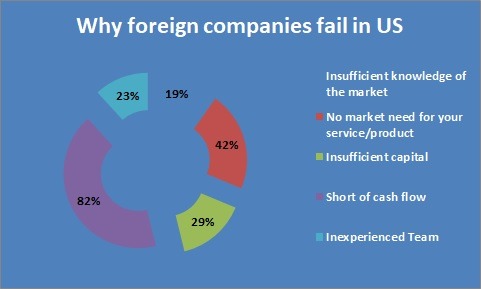
6 reasons why successful foreign companies fail in the US
If a company has a successful business in its country, it is very logical to think about expanding to another country. Most companies initially try to expand in their own region, but given the weight of the USA in global trade, it is only natural that at some point they will try to sell in the USA. In this article, I will talk about why many foreign companies fail to establish a successful brand in the USA and what factors to consider to improve the chances of success.
Why do foreign companies fail?
Depending on the source, between 42% and 56% of foreign startups fail in their attempt to conquer the USA market. In our experience, the six topmost reasons are:
- Insufficient knowledge of the market
- No market need for your service/product
- Wrong distribution model
- Insufficient capital
- Failure to generate enough cash flow
- Inexperienced Team
Let’s address each of these issues.
Insufficient knowledge of the market
The most common mistake foreign companies make is trying to conduct business in the USA in the same fashion and model as they do in their region. Business models have to adapt to the idiosyncrasy, regulations (both Federal and state-wise), and customer policies of the country. Be wise and adapt your model before attempting to enter the market. The figure below summarizes the aspects to consider to adapt your business model.

No market need for your service/product
Being successful in your country is no guarantee of success in the USA. Competition, prices, and marketing policies are always relevant, but the main ingredient is whether your products/services fit the needs of the market. Most of the time you need to modify your product, name, slogan, or packaging to appeal to your customers and meet the requirements of federal agencies like the FDA. In “9 tips for product selection for your distribution business” we provide a comprehensive list of issues to consider when selecting the product to sell.
Wrong distribution model
How distribution networks work relies largely on the size and complexity of the country. For example, most South American countries are considerably smaller than the US and the consumption is concentrated in a few regions and cities. Under these conditions, distribution rules and regulations, normally established by distributors and retail chains, tend to work in concert with distributors. However, in large and complex countries like the US, distribution rules are set by retail chains and distributors must commit to them.
If you structure your business plan around the way distribution works in your country, you will probably be bound to fail. In our posts “What is the best way to get your product in stores?” we detailed how the distribution network works in the US. Be wise and dimension your business based on the realities of the US market.
Insufficient capital
Most foreign companies finance their initial operation in the USA with bootstrap funds. For newcomers, access to financial instruments or external funding is very difficult. The most common mistake I have seen in most Business Plans is the undervaluation of the complexity to access the customer. The USA is one of the easiest countries to incorporate a business in, but is one of the most complex for customers (such as retail chains) to allow you to engage in the value chain. The result is an underestimation of the required capital. Be realistic and insert in your plan medium to long delays from when you enter the actual sale and reach the leverage point.
Another issue to consider is the infrastructure of the business, like buying vs renting, outsourcing vs developing your own structure, etc. The simpler your initial structure dimensions, the lower the capital and investment needs.
Failure to generate enough cash flow
Although you eventually manage to get your product/service to the end-user, most companies fail to generate enough cash flow to keep the product on the market until the leverage point is reached. Depending on the type of product and the marketing budget, there are several ways to try to shorten the product´s sales cycle:
- Conventional advertising
- Direct marketing actions at the point of sale, such as launch prices, temporary price reductions, BOGO, tasting, giving samples, etc.
- Social media marketing
- Alliances with third parties
- Private labels
Select the most appropriate strategies and marketing mix for your product, market, and budget projections.
Inexperienced Team
Understandably, most foreign companies want to start operations with their own executives. Although there is no doubt about the ability of these executives, they likely lack knowledge of the specifications of the US market. Considering the size and complexity of the US, it might be wise to include people from the target country in the start-up team, at least as consultants. They will provide valuable know-how and help reduce time to access the market and lower costs.
I hope this article has been helpful to you. I will continue to post information related to warehouse management, distribution practices and trends, and the economy in general. If you are interested in this article or want to learn more about Laceup Solutions, please subscribe to stay updated on future articles.
There is a lot of relevant information on our channel. Check out this video related to this article.


Sorry, the comment form is closed at this time.